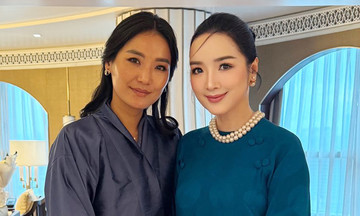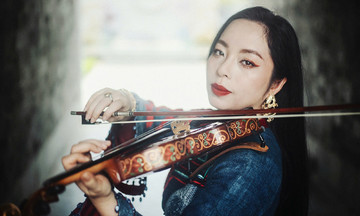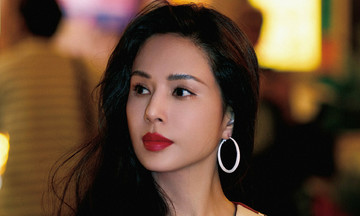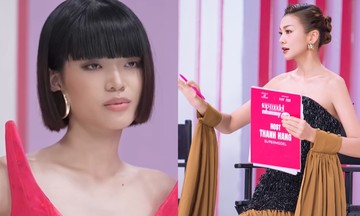I belonged to the second generation, or "class two," of the Ha Bac Quan Ho Folk Song Troupe. Although there wasn't much of a gap in years, I always considered myself part of the generation inheriting the legacy of our predecessors. And as you know, inheriting from artistic "giants" can be somewhat stressful, with moments of self-doubt about whether one can measure up. The first generation, or "class one," included artists like Thuy Cai, Quy Trang, Xuan Mui, Vu Tu Lam, Le Van Toan, Hai Phuc, Le Ngai, Khanh Ha, Hong Manh, and many others. Hearing this, you can probably imagine why the artists of my generation always pushed ourselves to strive harder. Our predecessors left us such valuable lessons; if we didn't live up to them, we would feel guilty, like we were letting them down. Time flies; now, everyone has retired, and some are no longer with us.
When I first joined the troupe, I was both a performer and a student. At 13 or 14, I was the youngest, my voice still clear and high-pitched. I remember practicing on the second-floor balcony every afternoon. People transporting goods by bicycle and those passing through Bo Son village would stop to listen. They were perhaps my first "audience," the ones who gave me early confidence in my abilities.
At that time, Mr. Sieu was the head of the quan ho troupe, and Mr. Xoi was my singing teacher—my first mentor on my artistic path. Youth has a valuable asset: passion. That passion, combined with dedication and love for art, is undoubtedly precious baggage, supporting each person on their journey to find valuable things. I was no exception. I brought all my enthusiasm, love, and passion to absorb the experience Mr. Xoi imparted. I strived to learn all the traditional melodies, from La Rang, Duong Ban Kim Loan, Cay Gao, Gia Ban, Hu La, La Hoi, to Tinh Tang, Cai A, Len Nui, Xuong Song, Cai Hon, Gio Mat Trang Thanh, Tu Quy, and more. Learning these melodies wasn't simple; it demanded serious practice under the methodical guidance of elders, encompassing rhythm, breathing, and ornamentation. The more challenging the task, the more determined I became; the most difficult melodies brought me the greatest enthusiasm and resolve.
Even as a young boy, I understood that art is not about memorization or imitation. Art is a flow that an artist can only master by intertwining it with the natural currents within their own body. I recall reading somewhere that talent isn't entirely innate, developing from birth like a mystical, divine source to eventually create an artist's gift. But artistic talent also doesn't emerge as an inevitable result of training, although without it, talent can wither. Understanding this, after learning each new melody, I dedicated time to practice, internalizing it until I was satisfied.
I can't define the level of satisfaction I sought in performing each melody. Things of great personal significance are difficult to evaluate on a specific scale. Perhaps, for me, satisfaction was the feeling of truly understanding and fully appreciating a folk melody. People in Kinh Bac have a saying about quan ho: "Quan ho is a tradition of Bac Ninh/Only those with true understanding can appreciate it." "Understanding correctly" means knowing the performance techniques, while "fully appreciating" requires grasping the cultural values tied to each melody. I was captivated by quan ho culture. I was passionate about expressing everyday life through song, showcasing the skillful, subtle, discreet, elegant, and meaningful interactions of Kinh Bac people. I'm proud that quan ho is not just a holistic art form, seamlessly blending music, lyrics, and courtship rituals, but also a cultural space—a place of performance, human connection, and the simple affection of genuine country folk, passed down through generations. I love quan ho not just because it's a cultural aspect of my homeland—a natural, instinctive love for one's roots—but also for the unique beauty of this traditional art form.
Part 1, To be continued
(Excerpt from the book Ke choc cuoi dan da, published by THBooks)
Xuan Hinh was born in 1963 but registered his birth year as 1966 to meet the age requirement for Hanoi University of Theater and Cinema. His name is associated with classical cheo melodies, quan ho folk songs, xam singing, and chau van ritual music. He is best remembered for works like Thi Mau Len Chua, Thay Boi Di Cho, Nguoi Ngua, Ngua Nguoi. He was awarded the title of Meritorious Artist in 1997. In March, he garnered attention for his singing and rapping in Bac Bling, collaborating with singer Hoa Minzy and musician Tuan Cry.











